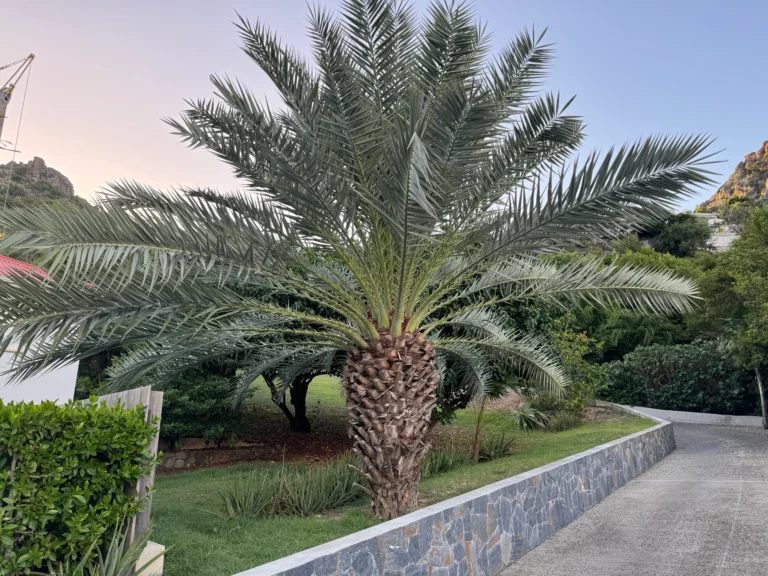Pindo Palm
Palm Overview
Botanical Name: Butia capitata
Add tropical charm and year-round color to your landscape with the Pindo Palm! This slow-growing, cold-hardy palm features striking silvery-blue fronds that arch gracefully from a stout, textured trunk. Reaching a mature height of 15–20 feet, it’s the perfect low-maintenance focal point for gardens, patios, and poolside spaces.
Hardy down to 15°F, the Pindo Palm thrives in full sun or partial shade, tolerates a range of soils, and even produces sweet, edible fruit known as “pindo dates.” Whether you’re coastal or inland, this palm brings beauty, resilience, and a touch of the tropics—without the fuss.
Plant Characteristics
| Characteristic | Description |
|---|---|
| Height | 15 to 20 feet (4.5 to 6 meters) |
| Canopy Spread | 10 to 15 feet (3 to 4.5 meters) |
| Trunk | Thick, textured, grayish-brown; single trunk with a slight curve or straight |
| Fronds/Leaves | Feather-shaped (pinnate), blue-green to silvery-gray; 3 to 6 feet long |
| Growth Rate | Slow to moderate (about 6 to 12 inches per year) |
Environmental Needs
| Environmental Factor | Requirement |
|---|---|
| Sunlight | Full sun to partial shade; prefers at least 6 hours of direct sunlight daily |
| Soil | Well-drained; tolerates sandy, loamy, or clay soils; slightly acidic to neutral pH |
| Watering | Moderate; water regularly during establishment, then drought-tolerant once mature |
| Hardiness | USDA Zones 8–11; cold hardy down to 15°F (-9°C) |
Fruit and Flowering
| Category | Description |
|---|---|
| Fruit | Edible, yellow-orange drupes called “pindo dates”; sweet and tangy flavor |
| Sex | Monoecious (male and female flowers occur on the same plant) |
| Time to Fruit | Typically begins fruiting at 6–10 years of age, depending on growing conditions |
| Fruit Season | Late spring to summer (typically ripens mid- to late summer) |
Uses
Ornamental Landscaping – Popular for its tropical look in residential and commercial landscapes
Specimen Tree – Works well as a focal point due to its graceful, arching fronds and stout trunk
Poolside Plantings – Tolerates heat and reflected light, making it ideal near pools or patios
Container Planting – Can be grown in large containers for patios, courtyards, or decks
Erosion Control – Strong root system helps stabilize soil in sandy or coastal areas
Edible Fruit Production – Produces sweet, tangy “pindo dates” used in jellies, preserves, and wines
Wildlife Attraction – Fruit attracts birds, bees, and other pollinators
Drought-Tolerant Landscaping – Suitable for xeriscaping once established
Low-Maintenance Planting – Requires minimal pruning and fertilization
Maintenance
Watering: Regular during first year; drought-tolerant once established. Avoid overwatering.
Fertilizing: Use palm fertilizer 2–3 times per year with micronutrients.
Pruning: Remove only dead/brown fronds; don’t over-prune green growth.
Mulching: 2–3 inches around base (not touching trunk) to retain moisture.
Pest/Disease: Monitor for scale or fungal issues; maintain airflow.
Cold Protection: Protect young palms in Zone 8 during freezes.
Weed Control: Keep area around trunk weed-free for best growth.
Soil: Ensure good drainage; avoid heavy clay.
